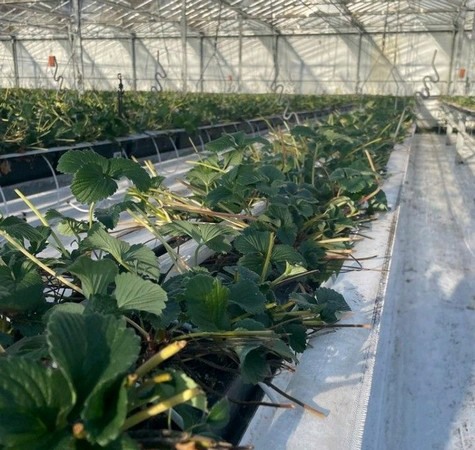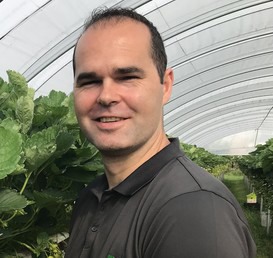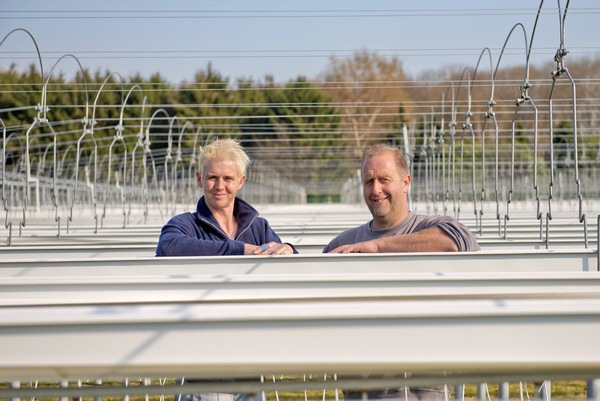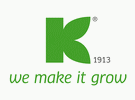Strawberry growers, especially, will commonly combine open-field, tunnel, and greenhouse cultivation. Klasmann-Deilmann, a European substrate supplier, has substrates for all these. GreenFibre substrates, which have GreenFibre wood fiber as the main component, are becoming increasingly popular. One of the growers using this substrate is Lemmen Aardbeien. Last year, this Dutch strawberry farm switched its entire open-field cultivation to this wood fiber substrate, and this winter, its continuous greenhouse crop followed.

A peek into Lemmen Aardbeien's greenhouse.
 Step toward ever-bearing crops
Step toward ever-bearing crops
Frank Lenkens, this substrate production company's regional sales representative, sees more and more growers taking this step like Lemmen Aardbeien.
These growers have recently been struggling with root problems and were also unhappy with the strawberries' firmness. But the cultivation of coconut fiber and using specific groundwater did not always meet their standards, as they said last year.
Frank knows that some growers find it nerve-wracking to switch to a different substrate mix for continuous winter crops. "They're often familiar with how substrates like peat react in the winter but not yet with newer substrates. We have plenty of experience with that and have done many trials with GreenFibre," he begins.
No root issues
One of these trials was done at the Hoogstraten Research Center in Belgium. Its results convinced the Lemmen Aardeien growers to make the switch in their open-field crop. The farm later ran a trial with continuous cultivation in the winter. In 2022, a successful open-field crop using GreenFibre led to the grower switching its greenhouse cultivation too.
On a recent visit to the greenhouse, Frank saw that the crop was looking good. "The plants are developing well, and there are no root issues. Those roots are distributed nicely throughout the substrate. Growers sometimes used to have red-root rot problems. No more," he says.

Liesbeth Beijes and Peter Lemmen of Lemmen Aardbeien.
Stable
GreenFibre, which Klasmann-Deilmann has been producing for about 15 years, has unique properties, Frank points out. The wood fiber the substrate producer uses for GreenFibre comes from Europe and is processed entirely in-house. "We've been doing this for many years using a very stable production process." Especially recently, more growers are choosing substrate mixtures with peat alternatives. That is partly also because of a recently signed deal that could decrease peat usage.
In the Netherlands, two GreenFibre variants are commonly used; one is fine, the other a medium course variety. Frank says a coarser variant is also used in Germany. Dutch strawberry growers use the medium coarse kind. The fine variant is used for products like soil blocks. Frank sees that nurseries have also started using the wood fiber substrate. "There, too, our substrate is performing well," he adds. He points out that blueberries, a perennial crop, are also grown successfully on GreenFibre.
No silicon
The basic GreenFibre variant contains roughly 50% peat in addition to wood fiber. Tests with less peat have been done, but peat has unique properties that cannot easily be replicated, so it remains an essential component in mixtures. Nevertheless, substrate producers like Klasmann Deilmann want to begin using less and less peat. In consultation with growers, Terraktiv Plus, a compost product, can also be added to the substrate mix. "Thar gives the soil life an extra boost. Some growers deliberately choose that, while others don't need it."
GreenFibre is a stable substrate that benefits growers. "It stays consistently moist and fluctuates far less," says Frank. Of particular note is that the product contains no silicon. "That can be detrimental to fruit coloring. The fruit gets white tips. Because GreenFibre is silicon-free, growers can be sure they aren't exceeding that critical limit if silicon is already present in the crop in other ways."
Readings
Though Klasmann-Deilmann has plenty of experience in how its substrates behave, taking readings remains vital. Lemmen Aardbeien uses sensors for that. The substrate producer offers these to growers, too, along with a digital cultivation log. Log&Solve.
"Growers can then get insight into what's happening in the soil. You can also get a good overview of why one substrate composition acts differently from another. Plus, it provides information via readings taken by other growers such as when spiders or whitefly appear, and what the crop's condition was when that happens," Franks concludes.
Klasmann-Deilmann supplies substrate, raw materials, and Growcoon plugs to the world's horticulture and arboriculture sectors. It has its own peat mills and production sites for renewable raw materials, where it produces high, consistent quality products using its knowledge and experience. It does final inspections of all products in its own laboratories. The company is RHP-certified.
For more information:
Frank Lenkens
Klasmann Deilmann Benelux B.V.
Email: frank.lenkens@klasmann-deilmann.com
www.klasmann-deilmann.com
